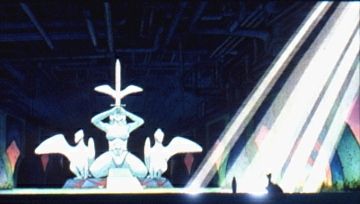

"The Legend of Taarna" began as a story drafted by Leonard Blum and Daniel Goldberg, writers retained by Ivan Reitman to develop a strong, conceptual screenplay for the movie.1
Originally there were 12 short stories in the Heavy Metal screenplay, and Arzak was to be the narrative linkup between the segments. Due to legal and financial complications in Europe, however, negotiations to the rights to Arzak fell through.2
The Taarna story evolved out of conferences among Reitman, Blum and Goldberg in early 1980.3 At a meeting with Reitman, a female animator voiced the idea that a heroine should be the central figure in one of the sequences, and her suggestion was eventually adopted.4
In the beginning, the writers planned to use the Taarna sequence as the linking device for the other stories.5 As Carl Macek explained, "Taarna was actually even a longer sequence. Originally Taarna was the linking device. . . . Instead of the green ball. Different little vignettes of Taarna: 30-seconds, 1-minute, 2-minutes as linking devises."6
After John Bruno agreed to work as the sequence director for the Taarna segment in August, 1980, he urged that the script be improved by pulling it together into a cohesive sequence, and adding elements suggestive of a Clint Eastwood/Sergio Leone western.7 According to Bruno, I had my own ideas of what Arzak was all about. To me, he was a loner, a character out of a Sergio Leone western. The mysterious man who never talked, who knew exactly who he was and what he had to do. It was an abstract Western relocated into a fantastic setting. The only difference was that Arzak rode a 'bird' instead of a horse.
8 Bruno saw Taarna as a female substitution for the Arzak story, and transferred this concept to her.
9
In December, Bruno's suggestions were adopted when progress on the sequence indicated that it would probably be the "most dramatic story,"10 and thus, the Loc-Nar in "Grimaldi," rather than "Taarna," became the linking story. In February 1981, a stronger ending to the sequence was added in accordance with Reitman's direction.11 In its final form, "Taarna" had a mind-boggling 330 scenes, composed of 130,000 drawings--all hand-painted.12
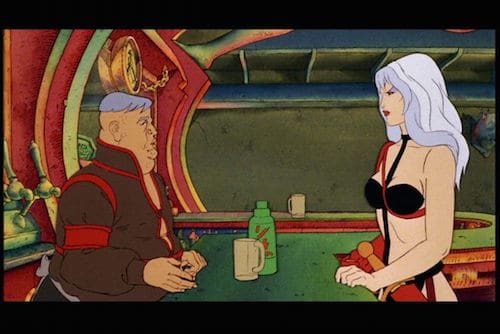
The plans for who Taarna would be were succinctly summed up by those closest to the production:
Dan Goldberg: "We really liked the idea of a woman with a sword who could use it. Who took no shit."13
John Bruno: "We did want to have this woman be the ultimate woman warrior. Not only does she not have a name or a voice, she's very focused on what she's going to do: she's just going to kill the bad guys."14
Mike Gross: "This story makes up for every frame of the film which might be thought to have a sexist bias against women. In 'Taarna' the heroine cuts a path of vengeance unparalleled in the history of animation."15
To establish Taarna's character,
Bruno originally envisioned a vignette to follow the Loc-nar's crash into the mountain:
we see a man running across the desert. A monster is chasing him. Out of the sun comes a girl, riding a giant bird, and flying right at us. . . . She is swinging a lariat. She flies down, ropes the monster, and ties it up. . . . She goes back and confronts the nomadic character on the desert. When he tries to rape her, she slugs him, ties him up, carries him back on the bird, and puts him down next to the creature, who eats him.16
At some juncture, this scene was removed from the story.
The notorious hideaway
segment was originally planned to follow the destruction of Kraan. Bruno explained the evolution of this segment: In the original script, when she goes through the warrior ritual in her hideaway, she just lights incense, anoints herself with oil and receives special garments when she pushes a button in a rock. I expanded that sequence to at least five minutes and made it just a spectacular thing, which I think is called for in any 'origin' story. . . . I just went crazy with that sequence and I thought they would throw it out because I had gone too far and really strayed from the script. But they liked it and left it in just as we had done it.
17
Like the story, Taarna's physical appearance evolved, and was influenced by several artists at different stages in the production. J. S. Goert made some initial drawings which portrayed her as a blonde.18 According to Director Gerald Potterton, however, "Ivan [Reitman] . . . wanted her with a much sexier figure, which we all realized was the right way to go. Eventually we came around to that way of doing it."19 Goert's work 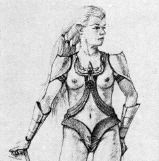 was followed by Howard Chaykin, who was retained in August, 1980.20 Chaykin, who had done some stories in Heavy Metal magazine, was sequestered in a Los Angeles hotel for a couple of weeks to generate multiple character designs, including Taarna.21 As Chaykin explained, "Since I was asked to create eclectic drawings for the 'Taarna' sequence, I had to avoid making them Conan clones or making Taarna another Barbarella. So I hid away and concentrated on Japanese design, which has that SF sort of stylization anyhow."22
was followed by Howard Chaykin, who was retained in August, 1980.20 Chaykin, who had done some stories in Heavy Metal magazine, was sequestered in a Los Angeles hotel for a couple of weeks to generate multiple character designs, including Taarna.21 As Chaykin explained, "Since I was asked to create eclectic drawings for the 'Taarna' sequence, I had to avoid making them Conan clones or making Taarna another Barbarella. So I hid away and concentrated on Japanese design, which has that SF sort of stylization anyhow."22
In the original script, Taarna was a redhead who wore golden metal armor, but at some mysterious turn of events, she came to have white hair and a very insubstantial outfit. In any event, Chaykin's illustrations were modified, and Renee Holt and Phil Norwood prepared simplified model sheets for the animators.23
Much of the Taarna sequence was derived from the style of Jean Giraud (Moebius).24 Mike Ploog, a well-known cartoon artist who worked extensively on the "B-17" segment, was also asked to work on Taarna. Together with Chaykin, Ploog developed a great deal of conceptual artwork which gave the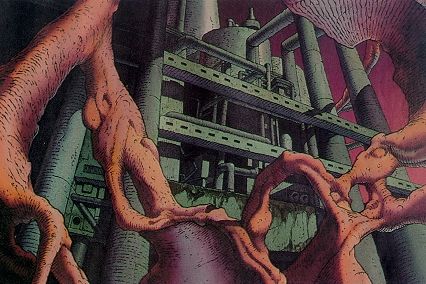 Taarna sequence its ambience of monumental post-technological decay, including the appearance of the desert, with its strange refineries and pipes,25 and in particular, the skeleton/pumping station, and artwork for the scenes depicting Taarna's torture and banishment into a pit.26(Reitman shortened the latter segment, cutting out about ten minutes of film in which Taarna was aided by a farmer named "Zukus."27 Zukus is still seen in the movie as the unfortunate soul cast into the pit.) Artists Christian Bedard and Brent Boates of Vancouver, Canada were also employed to create background art.28 Danielle Marleau, a background painter from Montreal, supervised the creation of the backgrounds, adapting the film to match "the look" of the Heavy Metal magazine. Background drawings were photocopied onto watercolor paper to experiment with color.29, 30 Bedard's artistic strengths in rendering fantastic architecture were used.31 Boates' style, in particular,
Taarna sequence its ambience of monumental post-technological decay, including the appearance of the desert, with its strange refineries and pipes,25 and in particular, the skeleton/pumping station, and artwork for the scenes depicting Taarna's torture and banishment into a pit.26(Reitman shortened the latter segment, cutting out about ten minutes of film in which Taarna was aided by a farmer named "Zukus."27 Zukus is still seen in the movie as the unfortunate soul cast into the pit.) Artists Christian Bedard and Brent Boates of Vancouver, Canada were also employed to create background art.28 Danielle Marleau, a background painter from Montreal, supervised the creation of the backgrounds, adapting the film to match "the look" of the Heavy Metal magazine. Background drawings were photocopied onto watercolor paper to experiment with color.29, 30 Bedard's artistic strengths in rendering fantastic architecture were used.31 Boates' style, in particular, ultimately became the final 'look' of the sequence.
32
The art-deco style buildings for the city of Kraan, including the fantastic Council Chambers, 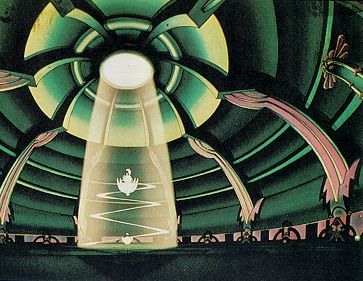 were conceived by Charles White, III and Alex Tavoularis.33 Associate Producer Mike Gross commented, "I wanted the trashy, campy kind of buildings and gateways that could have been in a garish Hollywood movie from the thirties."34 Zdenko Gasparovic, a renowned Yugoslavian animator, animated the council chamber and revolving dias (as well as some of the fight scenes in the barroom sequence). Jose Abel, a French animator born in Portugual, animated the extremely graphic death throes of the pageboy in the council chamber scene.35
were conceived by Charles White, III and Alex Tavoularis.33 Associate Producer Mike Gross commented, "I wanted the trashy, campy kind of buildings and gateways that could have been in a garish Hollywood movie from the thirties."34 Zdenko Gasparovic, a renowned Yugoslavian animator, animated the council chamber and revolving dias (as well as some of the fight scenes in the barroom sequence). Jose Abel, a French animator born in Portugual, animated the extremely graphic death throes of the pageboy in the council chamber scene.35
John Bruno provided the impetus for the opening flight sequence, in which the view travels across a dynamically changing landscape in accompaniment to Taarna on her bird.36 This effect had never been attempted before in an animated feature; typically there is one background per scene. The segment was done using multiple, miniature three-dimensional landscapes created by Jerry Allen in a quonset hut near his Long Beach home.37, 38 Allen really liked the concept for [the] opening shot . . . of Taarna flying her bird over canyons, cliffs and deserts, then approaching the horizon where a spot grows into an 800 foot skeleton.
39 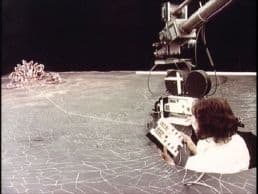 These were filmed in high contrast black and white with a computer-controlled camera ("the Anicam"40) by Alex Funky (who was more recently involved in The Lord of the Rings movies) and Don Admundson of Precision Film Group, and were then converted to animation cels.41
These were filmed in high contrast black and white with a computer-controlled camera ("the Anicam"40) by Alex Funky (who was more recently involved in The Lord of the Rings movies) and Don Admundson of Precision Film Group, and were then converted to animation cels.41
According to John Bruno, the camera programs were coordinated to his storyboards. This included the stalling out
sequence, which he explained as follows: I am a licensed pilot, and . . . as I storyboarded out this episode, I tried to remember every feeling of what it was like to fly low over the landscape. At one point, Taarna's bird stalls out and flies into a pit. . . . [T]he camera's point of view stalls, flutters, then banks over 170 degrees and dives into the canyon.
42
Jerry Allen created the bizarre skeleton overlying the pumping station from badger bones, a dog's skull, and a human spine.
43 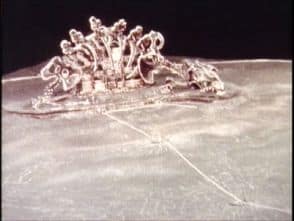
Approximately nine hundred watercolor backgrounds were painted by Eric Semones and a group of artists for this segment.44, 45 Taarna's flight around the skeleton and through the pumping station was filmed using a multi-plane technique in order to provide added depth to the shot. Maxwell Morgan began shooting this footage in January 1981.46
Portions of "Taarna" were rotoscoped to capture the complex movement of Taarna and of other characters, and to provide consistency in the animation work being done at separate locations in the U.S. and Canada.47 As Carl Macek explained, "the concept here was that they were dealing with humans and most cartoons at the time were not dealing with humans, or if they were, they were doing them in a stylized manner . . . . So it was very difficult to do humans realistically and make it be convincing."48 The use of rotoscoping was very effective in achieving the realistic movement of the human figure, for example, of Taarna in the underground temple; as she walks among the ruins of the council chamber; and during the barroom confrontation.
To shoot the rotoscoping, Bruno took the painting done by Chris Achilleos to modeling agencies in Montreal in search of models six feet or taller who looked like Taarna.49 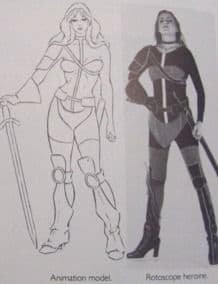 Carol Desbiens was felt to "exactly fit[]" the description.50 John Meighen and Jacqueline Claire Barley created the costume worn by Desbiens from Taarna's model sheets.51 Bruno directed and Paul Van der Linden photographed the live-action sessions over a week in October, 1980.52 Rotoscoping was used, in particular, for the "rotation sequence" in which Taarna dresses.53
Carol Desbiens was felt to "exactly fit[]" the description.50 John Meighen and Jacqueline Claire Barley created the costume worn by Desbiens from Taarna's model sheets.51 Bruno directed and Paul Van der Linden photographed the live-action sessions over a week in October, 1980.52 Rotoscoping was used, in particular, for the "rotation sequence" in which Taarna dresses.53
In December 1980, Bruno hired Harry Moreau, who did the special effects at the end of Star Trek: The Motion Picture (1979), to do the lighting effects for the conclusion of Taarna's hideaway segment, and the end of the whole sequence when the "Loc-Nar"finally meets its doom.54
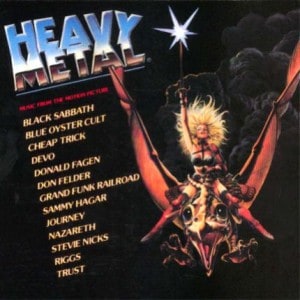
Rock music was used for specific scenes in the Taarna sequence. Devo wrote "Through Being Cool" for the encounter in the bar scene, a song described as "a clanking, electronic residue that suits the mise-en-scene perfectly."55 Legendary heavy metal band Black Sabbath wrote E5150, the dark, heavily synthesized music accompanying the opening scenes of the sequence, and "The Mob Rules," used during the scene in which the barbarians overrun Kraan. (Both songs are recorded on Sabbath's 1981 album).
Blue Oyster Cult wrote "Veteran of the Psychic Wars," which was used for the "Harry Canyon" sequence. Other songs that were not used in the movie are included in their 1981 album, "Fire of Unknown Origin." In particular, "Vengeance (The Pact)," was written with specific reference to the "Taarna" segment, as its title and lyrics indicate, but was not used in the film.
Reitman hired accomplished composer Elmer Bernstein to score Heavy Metal, including the "Taarna" sequence. He and Reitman agreed that the music would be composed as for a dramatic film, not animation. Bernstein has stated that he "wrote a particularly inspired score" for Heavy Metal, and in 1981 commented, "It's a matter of the degree by which you integrate different musical elements. Obviously, you pick music that stimulates a reaction. Since the animation medium is not lifelike, your music must really fit--it has to be something full, huge, adventurous."56 Bernstein composed the music in the Spring of 1981;57 it was performed by London's 96-piece Royal Philharmonic Orchestra in a church in England while Bernstein watched a sketch reel version of the movie on a TV system.58
Bernstein's music was released on an album entitled "Heavy Metal: The Score," supposedly bootleg, but with good sound quality. In 2008, Screen Archives Entertainment released the complete score (FSM1102), remastered from Bernstein's personal 1/4" stereo tapes (in excellent sound quality). A review of this album can be found here. Music from the Taarna Sequence was also recorded as one track on a 1993 Denon album entitled "Elmer Bernstein by Elmer Bernstein." The music from Taarna's "rotation sequence" also appears as a track on an album entitled "Space and Beyond," released in 1997 by Silva America.
Endnotes
1. R. Greenberger, "The Heavy Metal Story," Starlog, Sept. 1981, pp. 25, 61.
2. M. Stein, "The Heavy Metal Movie--An Interview with Sequence Director John Bruno," Fantastic Films, Nov. 1981, p.36.
3. B. Balfour, "Heavy Metal--the Making of the Movie," unpaginated insert to Heavy Metal (Sept. 1981).
4. Ibid.
5. Carl Macek, The Art of Heavy Metal: Animation for the Eighties (New York: New York Zoetrope, 1981), p.95.
6. Cliff Stephenson, "An Interview With Carl Macek," http://anime.about.com/.
7. B. Balfour, supra n.3.
8. M. Stein, supra n.2. Bruno, who had been requested at an earlier stage to become involved in the film, was contacted by Michael Gross in June/July of 1980 to help with the Gremlin (B-17) sequence. Bruno initially thought that he would only be assisting with the storyboarding for Taarna, but was made director of the episode in August, 1980. Ibid.
9. Ibid.
10. B. Balfour, supra n.3.
11.Ibid.
12. Ibid.
13. Daniel Goldberg, quoted in Imagining Heavy Metal (1999).
14. John Bruno, quoted in Imagining Heavy Metal (1999).
15. C. Macek, supra n.5, at 95 (quoting Michael Gross, Associate Producer).
16. M. Stein, supra n.2, at 37.
17. M. Stein, supra n.2, at p.37-38.
18. B. Balfour, supra n.3.
19: K. Williams, "Gerald Potterton Interview," Miriad (5:1981), at p.21.
20. B. Balfour, supra n.3.
21. R. Greenberger, supra n.1, at 61.
22. B. Balfour, supra n.3.
23. Ibid.
24: K. Williams, supra n.19, at 21.
25: Ibid.
26. R. Greenberger, supra n.1, at 61; B. Balfour, supra n.3; C. Macek, supra n.5, at 97-98.
27. B. Balfour, supra n.3.
28. Ibid.
29. Ibid.
30. M. Stein, supra n.2, at 37.
31. Ibid.
32. Ibid.
33. B. Balfour, supra n.3.
34. C. Macek, supra n.5, at 108.
35. B. Balfour, supra n.3.
36. Ibid.
37. Ibid.
38. M. Stein, supra n.2, at 38.
39. Ibid.
40: K. Williams, supra n.19, at p.21.
41. B. Balfour, supra n.3.
42. M. Stein, supra n.2, at 38.
43. B. Balfour, supra n.3.
44. Ibid.
45. M. Stein, supra n.2, at 39.
46. C. Stephenson, supra n.6.
47. B. Balfour, supra n.3.
48. C. Stephenson, supra n.6.
49: B. Balfour, supra n.3. According to Gerald Potterton, Frank Frazetta was initially approached to create the poster for the movie and designs for the Taarna sequence. Chris Achilleos was hired after the deal with Frazetta fell through. K. Davies, supra n.19, at 20.
50. B. Balfour, supra n.3.
51. Ibid.
52: Ibid.
53. Carl Macek, Catalog of Artwork from Taarna Sequence, undated, at p.2.
54. B. Balfour, supra n.3.
55. R. Greenberger, supra n.1, at 27.
56. B. Balfour, supra n.3.
57. Ibid.
58. C. Macek, supra n.5, at 15.